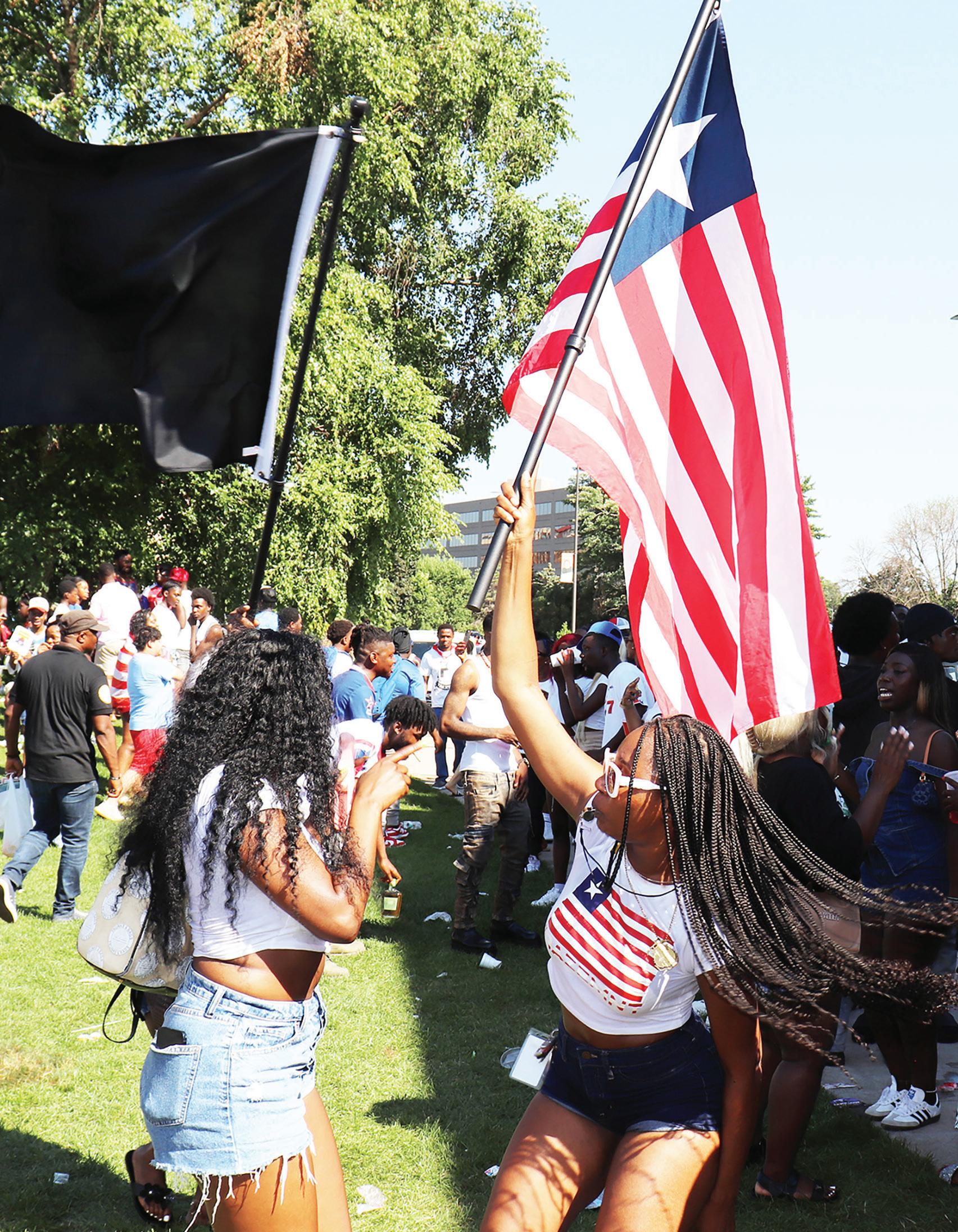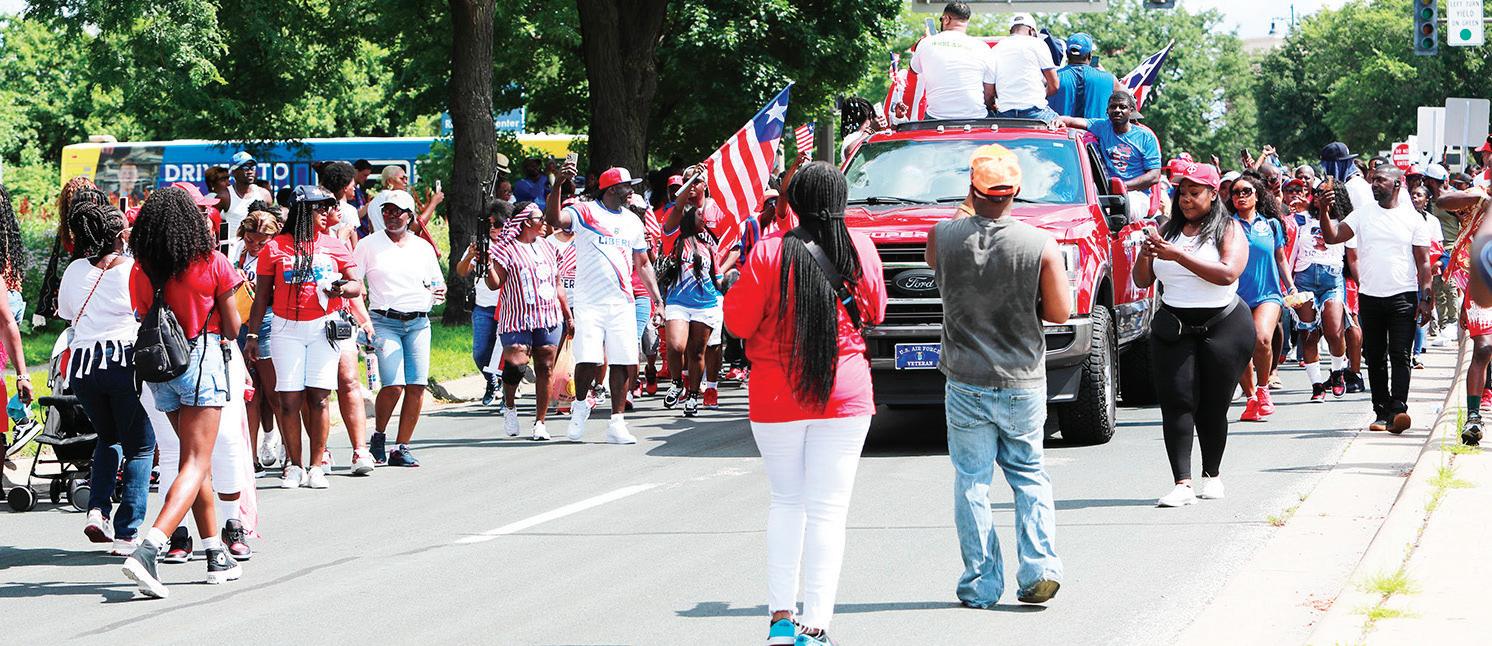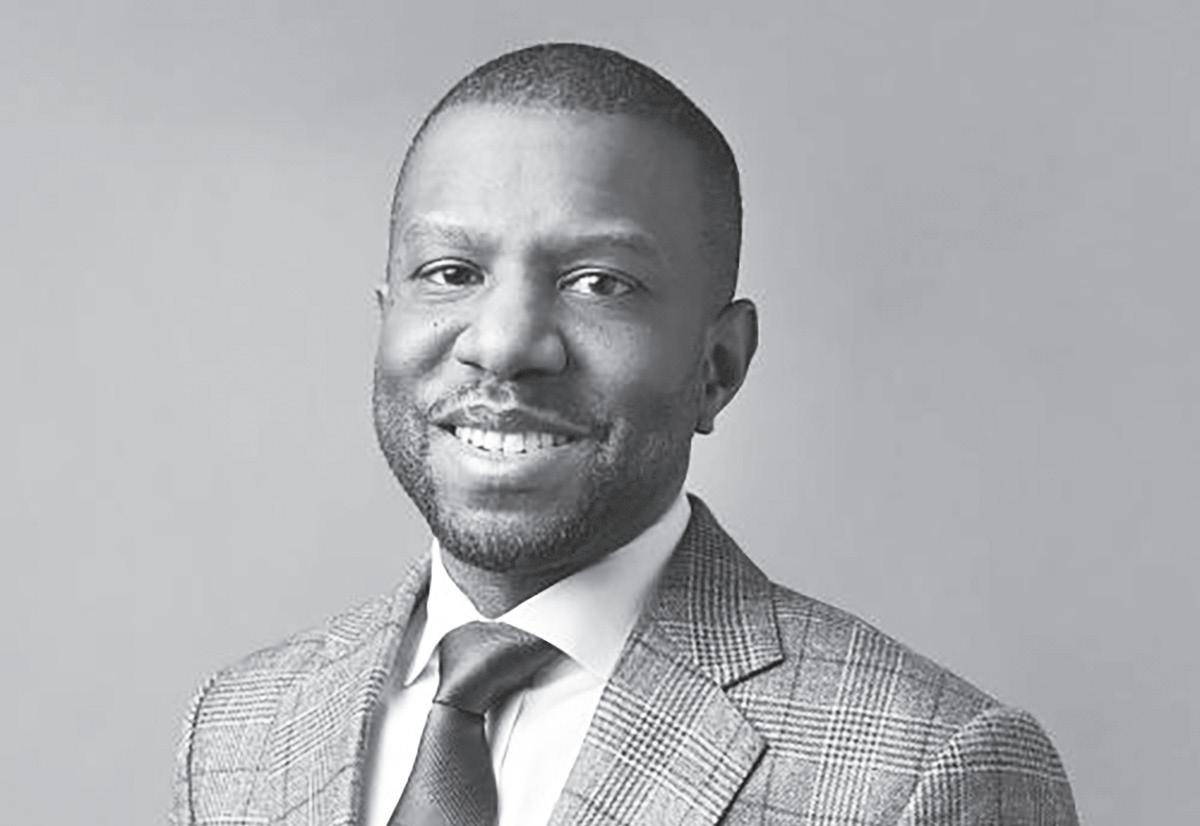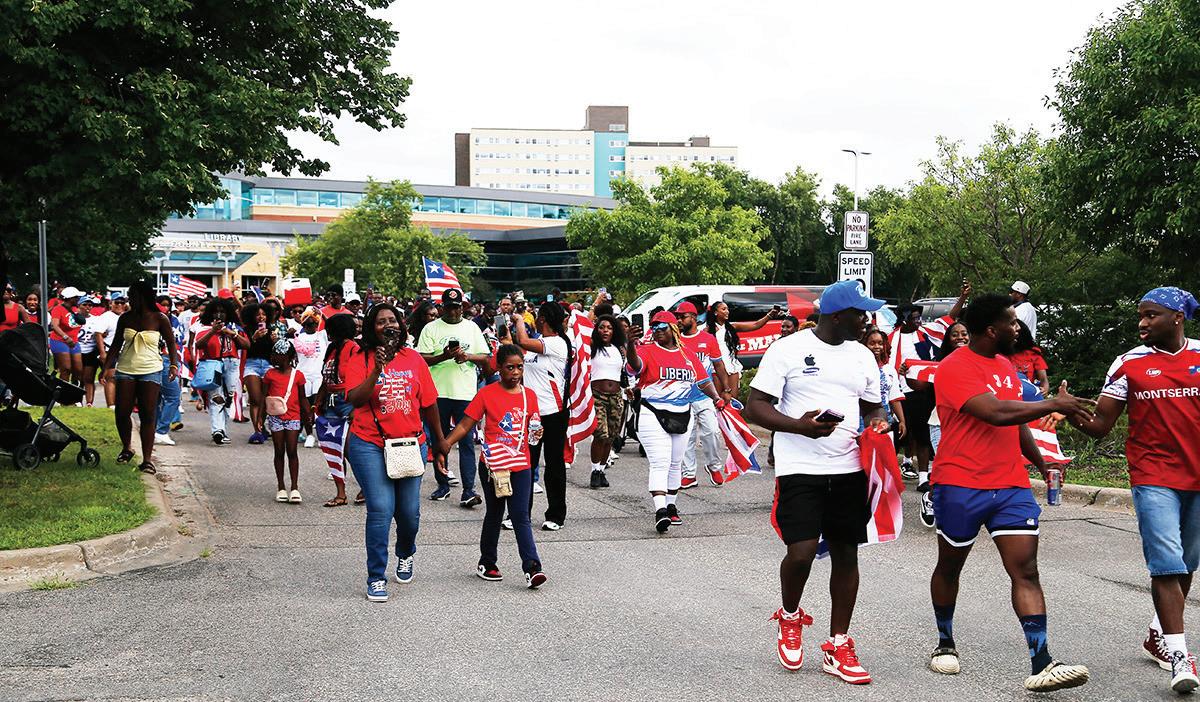HAPPY BIRTHDAY LIBERIA




By Tom Gitaa Mshale
The sounds of Afrobeat, and in particular songs by Skrewfaze and Deetweh, pulsated along Shingle Creek Parkway in Brooklyn Center on Saturday, as the Liberian Independence Day Parade made its way from the Brookdale Library headed to Bass Lake Road before looping around to conclude at Centennial Park for daylong festivities.
The parade started with hundreds of Liberian Americans waving the Liberian flag, dancing and singing to Skrewfaze’s “Liberia Independence Day” as they marched through the usually busy thoroughfare that was closed off for the day, with music blaring from pickup trucks that led the parade.
By the time the parade reached Centennial Park the number of revelers had grown to a few
thousand as some who could not make it to the parade arrived at the site of the day’s celebrations.
At the park, the celebration intensified, as ground-vibrating music blared from loud speakers placed at the pavilion.
“We finally get to have our own parade to celebrate like other large immigrant communities,” said Fatu Konneh, who lives in Brooklyn Center and had come to represent The Bazemnt
Lounge, a downtown Minneapolis club popular with trendy Africans.
After riding on the Bazemnt Lounge float in the parade, Ms. Konneh positioned herself at the front row of the pavilion and enthusiastically waved the Liberian flag while dancing amongst the large crowd; she was dressed appropriately for the
Liberia Cont’d on Pg. 6

In May, the United States flew a group of eight migrants to Djibouti, a small state in the Horn of Africa. For weeks, the men — who are from Cuba, Laos, Mexico, Myanmar, Vietnam and South Sudan — were detained in a converted shipping container on a U.S. military base. More than a month later, the U.S. Supreme Court ruled that the men, who had all been convicted of serious crimes, could be transferred to their final destination: South Sudan, a country on the brink of famine and civil war. Tom Homan, the border czar, acknowledged that he didn’t know what happened to them once they were released from U.S. custody. “As far as we’re concerned,” he said, “they’re free.”
Deporting foreign nationals to countries other than their homeland has quickly become a centerpiece of the Trump administration’s immigration policy. Thousands of people have been sent to countries in the Western Hemisphere, including Costa Rica, El Salvador, Mexico and Panama. At a recent summit of West African leaders, President Trump pressed them to admit deportees from the United States, reportedly emphasizing that assisting in migration was essential to improving commercial ties with the United States. All told, administration officials have reached out to dozens of states to try to strike deals to accept deportees. The administration is making progress: Last week, it sent five men to the tiny, landlocked country of Eswatini in southern Africa after their home countries allegedly “refused to take them back,” according to an assistant homeland security secretary, Tricia McLaughlin. The terms of the deal were not disclosed.
In some ways, this is nothing new. It has become increasingly common for the world’s most prosperous countries to relocate immigrants, asylum seekers and refugees to places with which they have little or no prior connection. Previous U.S. administrations from both parties have sought third-country detentions as easy fixes. In the 1990s, Presidents George H.W. Bush and Bill Clinton both sent thousands of Haitian refugees to detention camps in Guantánamo Bay before forcibly repatriating most of them to Haiti.
What is new about the Trump administration’s deportation efforts, unlike previous European or even past U.S. attempts, is their breadth and scale, effectively transforming migrant expulsions into a tool for international leverage. By deporting foreign nationals to often unstable third countries, the Trump administration is not only creating a novel class of exiles with little hope of returning to either the United States or their country of origin, but also explicitly using these vulnerable populations as bargaining chips in a wider strategy of diplomatic and geopolitical deal making.
This strategy marks a significant evolution in a practice that has been gaining traction throughout the developed world. In the early 2000s, Australia devised the so-called Pacific Solution, an arrangement that diverted asylum seekers arriving by boat or intercepted at sea to holding centers in the island states of Nauru and Papua New Guinea in exchange for benefits, including development aid and financial support. In 2016, amid what was then the largest displacement of people in Europe since World War II, the European Union struck a deal that allowed it to send migrants arriving in Greece from Turkey through irregular means back to Turkey — to the tune of six billion euros.
Some of these efforts have faced legal challenges. Starting in 2022, for example, the United Kingdom attempted to establish a program that would have automatically deported some asylum seekers and migrants entering the U.K. illegally to Rwanda, costing over half a billion pounds — more than 200 million of which were paid upfront. The British Supreme Court ruled that the policy was unlawful, and Britain’s prime minister scrapped the plan last year.
But many countries remain undeterred. In 2023, Italy signed a deal that allowed it to send certain migrants rescued by Italian ships in international waters to detention centers in Albania, and is persisting with the effort even in the face of legal setbacks. This spring, the European Union
proposed establishing “return hubs” in third countries for rejected asylum seekers.
Although these deals take various forms, states that enter them are motivated by similar concerns. The world’s richer states wish to retain control of their borders and are particularly aggrieved by the arrival of people who enter by irregular means, especially when they are coming from low-income countries that many associate with crime, violence and terrorism. Governments in destination countries are attracted to such deals by the promise of financial, diplomatic and military support.
Throughout much of the West, as public sentiment has turned against newcomers, policymakers and pundits alike have portrayed migrants as a threat to national security and social stability. These migrants, they argue, impose an unsustainable burden on government budgets and public services and deprive citizens of jobs. Racism and xenophobia, fueled by populist politicians and right-wing media outlets, have also played an important part in creating a toxic environment in which the expulsion of migrants to arbitrary destinations is increasingly considered legitimate.
But how legitimate is it? Third-country deportations often sidestep due process and violate international law, under which it is forbidden for states to deport such people to any place where their life or liberty would be at risk. It is also plainly unethical, imposing additional stress on people who have undergone traumatic journeys and who are then dumped in far-off, unfamiliar places.
Several of the countries slated as deportation destinations have bleak human rights records and are unsafe for all civilians, let alone foreign deportees, who are likely to be targets of abuse and exploitation. In the worst instances, as with U.S. deportees in El Salvador, they can find themselves in jails where the authorities routinely inflict physical and psychological violence on inmates.
These deportation deals also have corrosive consequences for international politics. They encourage smaller, weaker countries to engage in transactional behavior, commodifying human life by trading immigrant bodies for cash, development aid, diplomatic support and international impunity. They may even strengthen the impunity of authoritarian regimes that violate the human rights of their own citizens. In the case of El Salvador, for example, deportees from the United States reportedly included some leaders of the criminal gang MS-13, who were thought to be in a position to expose links between President Nayib Bukele and the gang.
For nearly three-quarters of a century, a network of international instruments, institutions and norms have acted as guardrails, if imperfect ones, to ensure that refugees, asylum seekers and other migrants are treated humanely. Now it seems as though the president is looking to rewrite the rules of this system to one in which people are pawns.
By expanding the practice of forced relocation, Mr. Trump is using migrants as currency in a global network of geopolitical negotiation. His administration is normalizing the use of vulnerable people as bargaining chips to extract better deals with friends and foes alike. He is setting a dangerous precedent for other democratic countries by ignoring the moral and reputational cost of shipping desperate people into terrible conditions. As Mr. Trump works to bring this new paradigm to life, leaders the world over will be watching closely. If he can pull it off, so can they.
Jeff Crisp is a research fellow at the University of Oxford’s Refugee Studies Center and was formerly the head of policy development at the Office of the United Nations High Commissioner for Refugees. He wrote this for the New York Times where it first appeared.

By Brandon Tensley Capital B
The U.S. Supreme Court this month gave the Trump administration permission to continue with its plans for mass firings at the U.S. Department of Education, as the agency also announced that, on Aug. 1, interest would start accruing again for the roughly 8 million borrowers on the Saving on a Valuable Education (SAVE) plan.
These developments have thrown the department and student loan borrowers into a state of uncertainty.
For months, there’s been speculation about the future of the department that determines how the federal government’s education budget is spent and how civil rights protections for students are interpreted.
This mass termination doesn’t appear to be affecting all department employees evenly.
“The people they seem to be keeping are white men who happen to have graduated from very conservative schools,” Sheria Smith, the president of the American Federation of Government Employees Local 252, a department union, told MSNBC’s Rachel Maddow on Tuesday, while women and people of color are being let go at a higher rate.
This upheaval raises major concerns for Black borrowers, who not only owe a disproportionate amount of the national student loan debt, but also, compared with their white counterparts, are more likely to struggle to pay back their loans.
Roughly 44 million Americans have student loan debt. Many are worried about what the Trump administration’s gutting of the agency, which oversees a $1.7 trillion portfolio of student loans, might mean for their livelihoods.
Education Secretary Linda McMahon pushed back against criticism of the cuts, insisting that they were for the benefit of students.
“The U.S. Department of Education will now deliver on its mandate to restore excellence in American education,” she said in a statement following the Supreme Court’s decision. “We will carry out the reduction in force to promote efficiency and accountability and to ensure resources are directed where they matter most — to students, parents, and teachers.”
Trump ultimately wants to shut down the department.
Ivory Toldson, a professor of counseling psychology at Howard University, has long been concerned about the higher education marketplace, which he argues incentivizes students to prioritize a college’s reputation over its cost, a tendency that can plunge them into extraordinary student loan debt.
But the administration, he continued, appears to be more interested in destabilizing this marketplace, not improving it or helping students to navigate it.
“A lot of what Trump is doing is regressive. It’s not consistent with what students or schools need,” Toldson, who previously served as the director of

education for the NAACP, told Capital B.
As the overhaul of the federal government barrels ahead, here’s what borrowers need to know about the administration’s efforts to eliminate the agency that manages their loans — and the steps they can take to prepare for any upcoming hurdles.
Can Trump dismantle the Department of Education?
On the campaign trail, Trump frequently railed against the department, claiming that it was run by “radicals, zealots, and Marxists” and promising to shutter it.
But it’s uncertain how he would do that. Closing a federal agency requires an act of Congress, and such legislation isn’t likely to get the 60 votes necessary to overcome a filibuster in the U.S. Senate — where Republicans hold 53 seats — and advance to a final vote.
Still, the administration’s assault on the department, which Congress created in 1979, has generated alarm among its employees, both past and present.
Under the Obama administration, Tyra Mariani, the founder and principal of the consulting firm UP Advisors LLC, was appointed chief of staff to the U.S. deputy secretary of education and deputy chief of staff to the U.S. secretary of education, helping to shape priorities across different levels of schooling.
She previously told Capital B that it’s “extremely heartbreaking” to watch Trump and Elon Musk attack an agency designed to ensure that every young person, especially those from Black communities, has access to a quality education.
“It’s hard,” Mariani said. “You’re looking at your communities, and you know that Black and brown communities will be most affected by all of this undoing.”
What actions might the administration take?
While shutting down the department
would prove to be an uphill battle, Trump can still dramatically restructure the department and use it to carry out his agenda. In fact, we’ve already seen the administration take steps in this direction.
For instance, under Trump’s influence, the department has announced that it plans to “reassess” and potentially restrict borrower-defense regulations. Introduced in 1995, these regulations have allowed borrowers who have been defrauded or intentionally misled by their schools to be released from their student loan debt.
When Joe Biden was in the White House, he forgave around $30 billion in debt for 1.7 million borrowers under the Borrower Defense to Repayment program. This was a boon to the Black students, who are disproportionately targeted by for-
initiatives, or lose federal dollars.
“The term ‘DEI’ stands for ‘diversity, equity, and inclusion,’” Toldson said. “If you’re against diversity, that means you want white spaces. If you’re against equity, that means you want inequitable spaces. And if you’re against inclusion, that means you want to exclude.”
He surmised that if Black students feel less protected at predominantly white institutions, they might start to look for more welcoming environments, including historically Black colleges and universities, which tend to be cheaper tuition-wise.
What might happen to incomedriven repayment plans?
Several IDR plans have been introduced under a number of different administrations.

profit and predatory institutions.
Additionally, layoffs have upended the department, as they have large swaths of the federal government, and the Trump administration has ramped up its war on racial equality by giving universities an ultimatum: axe diversity





weather, in shorts and white t-shirt emblazoned with the Liberian flag. “This is precious,” she said. “We have been acknowledged by the state.”
Ms. Marie Dweh, co-founder of We Are Liberian, the nonprofit that organized the parade said in media interviews leading to the event that it was the first time such a parade was being held in the nation. With a Minnesota population of between 20,000-35,000, according to Minnesota Compass, Dweh said now is the time because “What better time than now to come together and just showcase our culture?” The city where the parade took place elected its first Black mayor in 2018 and he happened to be Liberian-born.
Minnesota has the largest number of Liberians in the nation and they are among the ‘Big Five’ of African immigrant populations in Minnesota that include Somalis, Ethiopians, Kenyans and Nigerians.
Minnesota Lt. Gov. Peggy Flanagan was the most high-ranking state official at the historic event and presented the Governor’s proclamation reaffirming July 26 as Liberia Independence Day.
Flanagan who is a candidate in the 2026 open seat for U.S. Senator told the crowd to be proud of their Liberian heritage, eliciting wild cheers.
Speaking without written notes before reading Gov. Walz’s proclamation, Flanagan told the crowd “I want you to remember where you come from in this
moment, when there are people who are trying to divide us,” adding “I want you to be very clear that resilience is in our bones, that our ancestors and leaders have dreamed us into this moment, and you will carry on and live those big bold dreams for your people and community.”
For many that showed up Saturday, the parade and festivities represented a celebration of Liberian culture, and most importantly a reminder of life in Liberia.
Waddie Kolenky Clemens and her husband Ce-Amavie drove from their home in the Minneapolis suburb of St. Anthony to partake in the festivities. As they took shelter from the hot sun under a tree, hours after the parade, they told Mshale they had a “great time” marching, and that it was a long time coming given the years Liberians have been part of life in Minnesota.
“We came out as Liberians to support our community as we do something brand new, I can’t wait to see what they would do next year” Waddie said. “The energy is very good and it reminded me of being back home, although we usually don’t have the floats.”
Food vendors had a good day going by the long lines at their stands. Food choices ranged from Liberian cuisine and other African countries but also included a Jamaican food stand.
One of the food vendors was Good Vibes African Cuisine whose owner, Chef Stephen, was all smiles as he grilled chicken with his son Isaiah as a long line of buyers formed.
“Can’t ask for anything better than
this, it’s a good crowd, one of the best I have done” he said as he shuffled between the grill and the supply boxes.
The parade was by far the event that drew the most Liberians in weekend long activities organized to celebrate the country’s independence due to its cross generational appeal. Everyone –from little babies wearing earmuffs to protect their hearing to grandparents with strollers were represented. Some revelers brought their dogs including Marvel Maxwell of Brooklyn Park whom we caught up with as she left the event. She said her dog Simba “enjoyed the event even with the hot weather.”
“The event was awesome; I saw peace and I saw Liberians at their best” she said.
Other weekend events to celebrate the 178th Independence Day included sports, concerts at various venues and an Independence Day Ball in Brooklyn Park hosted by the Organization of Liberians in Minnesota (OLM).
Minnesota House District 34B candidate Erickson Saye who is on the ballot in next month’s special primary election to replace the late Melissa Hortman, took part in the parade and a short while later posted on social media that he was a proud Liberian “born and raised,” and was proud of the strength, culture and unity Liberians have brought to their adopted state. Virtually the entire southern border of District 34B lines up to District 38B where the parade took place.
“But even with our size and impact, we still lack representation at our State

Capitol,” he said. “That’s why so many in our community encouraged me to run for the Minnesota House. We can no longer stand by and ask, “Why not us?”—it’s time for us to step up and be the change we want to see in the world.”





Based Repayment (IBR) plan came about during the President George W. Bush era. And the Income-Contingent Repayment (ICR) plan was established under President Bill Clinton.
The SAVE plan, which lowered monthly payments for millions of borrowers and sped up the pace of loan forgiveness for many others, replaced REPAYE, and it was Biden’s contribution to the landscape.
But the current outlook is challenging, Stanley Tate, an attorney specializing in student loan law, told Capital B. A U.S. appeals court in February blocked the SAVE plan and ended the 0% interest forbearance.
The administration is encouraging borrowers to switch to a plan that it’s approved. One of the suggested routes is the IBR program. The department this month paused forgiveness through the program, saying that it will resume once the agency has updated its systems.
Starting July 1, 2026, new borrowers have to pick between two options. One is a standard plan that gives borrowers 10 and 25 years to repay their loans using a fixed monthly payment, and the other is the Repayment Assistance Plan, which allows borrowers to use between 1% and 10% of their discretionary income for monthly payments.
Current borrowers have until July 1, 2028, to switch to a new option. By ending the 0% interest forbearance, the administration hopes borrowers will switch sooner rather than later.
Student loan experts note that, if borrowers switch plans, they should expect their monthly payments to increase, since the SAVE plan was the most affordable option available — some low-income borrowers paid $0 a month.
There’s a silver lining, however.
“IBR was established by a congressional act,” Tate said, “and as a result, it’s likely to remain stable unless explicitly overturned by Congress — a scenario I don’t see as probable.”
How can borrowers make decisions that protect their credit?
Borrowers must make strategic decisions based on their individual circumstances, Tate explained.
For some, this might mean sticking with their current plan and waiting to see how SAVE litigation plays out. Others, particularly those who are closer to securing loan forgiveness, might benefit from switching to the IBR plan once it’s available again. Still others might choose to exit the federal loan system entirely by paying off their loans.
“What I strongly caution against is the notion of simply abandoning payments altogether,” Tate explained.
“The Department of Education has extraordinary collection powers that can make this strategy extremely costly in the long run. It can garnish wages, seize tax refunds, and take Social Security benefits — all without obtaining a court order. These collection tools are far more powerful than what private creditors have at their disposal.”
Failing to pay loans, or paying them late, also can hurt borrowers’ credit scores.
The key, Tate added, is making informed decisions based on your current situation while also staying prepared for potential changes in the system.
Is this the first move to eliminate the department?
Trump’s attempts to shutter the department might be the most significant in recent years, but he isn’t the first Republican leader to make this effort.

Ronald Reagan was determined to extinguish the department when he entered the White House in 1981, at the height of an era marked by attacks on the Civil Rights Movement and other liberation struggles.
“The budget plan I submit to you on Feb. 8 will realize major savings by dismantling the Department of Education,” he said in his 1982 State of the Union address.
But Reagan ran into opposition from Democrats in Congress. Eventually, he abandoned his plans for the department.
federal educational programs could be administered effectively without a Cabinet-level agency. While I still feel that this is the best approach, that proposal has received very little support in the Congress.”
To avoid some of the policy challenges Reagan faced, Bush, years later, decided not to eradicate the department. Instead, he opted to demand more from educators, signing into law the No Child Left Behind Act, intended to overhaul schools that were considered to be “failing,” according to standardized test scores.

“I have no intention of recommending the abolition of the department to the Congress at this time,” he said in a 1985 letter to Republican Sen. Orrin G. Hatch of Utah.
“I have previously recommended the abolition of the Department of Education,” Reagan explained. “This was because I believed that
Trump’s efforts not only continue Reagan’s agenda but accelerate it, with potentially detrimental consequences for Black communities.
“I think that the house of cards is going to fall,” said Toldson, the Howard professor, referring to the instability the administration is injecting into the education landscape. “It’s just a matter of when and where.”

By Giovanna Dell’orto Associated Press
Faith leaders across the U.S. are hoping a bipartisan bill, recently introduced in the U.S. Senate and House, might finally bring resolution to an immigration issue that has been hindering their service to their communities for more than two years.
In March 2023, the Biden administration made a sudden change in how the government processes green cards in the category that includes both abused minors and religious workers. It created new backlogs that threaten the ability of thousands of pastors, nuns, imams, cantors and others to remain in the United States.
The bill only tackles one small part of the issue, which sponsoring lawmakers hope will increase its chances of passing even as immigration remains one of the most polarizing issues in the country.
Faith leaders say even a narrow fix will be enough to prevent damaging losses to congregations and to start planning for the future again.
“Unless there is a change to current practice, our community is slowly being strangled,” said the Rev. Aaron Wessman, vicar general and director of formation for the Glenmary Home Missioners, a small Catholic order ministering in rural America.
“I will weep with joy if this legislation passes,” he said. “It means the world for our members who are living in the middle of uncertainty and for the people they’ll be able to help.”
Two thirds of Glenmary’s priests and brothers under 50 years old are foreign-born — mostly from Kenya, Mexico, Nigeria and Uganda — and they are affected by the current immigration snag, Wessman added.
So are thousands of others who serve the variety of faiths present in the United States, from Islam to Hinduism to evangelical Christianity, providing both pastoral care and social services.
No exact numbers exist, but it is estimated that there are thousands of religious workers who are now backlogged in the green card system and/ or haven’t been able to apply yet.
How clergy get green cards — and why border crossings created backlogs
Congregations bring to the United States religious workers under temporary visas called R-1, which allow them to work for up to five years. That used to be enough time for the congregations to petition for green cards under a special category called EB-4, which would allow the clergy to become permanent residents.
Congress sets a quota of green cards available per year divided in categories, almost all based on types of employment or family relationships to U.S. citizens. In most categories, the demand exceeds the annual quota.
Citizens of countries with especially high demand get put in separate, often

longer “lines” — for several years, the most backlogged category has been that of married Mexican children of U.S. citizens, where only applications filed more than 24 years ago are being processed.
Also in a separate line were migrant children with “Special Immigrant Juvenile Status” — neglected or abused minors — from Guatemala, Honduras and El Salvador. Hundreds of thousands sought humanitarian green cards or asylum after illegally crossing into the U.S. since the mid-2010s, though the Trump administration recently cracked down on the program.
In March 2023, the State Department suddenly started adding the minors to the general green card queue with the clergy. That has created such a bottleneck that in April, only halfway through the current fiscal year, those green cards became unavailable.
And when they will become available in the new fiscal year starting in October, they are likely to be stuck in the six-year backlog they faced earlier this year — meaning religious workers with a pending application won’t get their green cards before their five-year visas expire and they must leave the country.
In a report released Thursday, U.S. Citizenship and Immigration Services blamed the EB-4 backlogs on the surge in applications by minors from Central America, and said the agency found widespread fraud in that program.
A ‘narrow fix’ bill to allow foreignborn clergy to remain in the US
The Senate and House bills would allow the Department of Homeland Security to extend religious workers’ visas as long as their green card application is pending. They would also prevent small job changes — such as moving up from associate to senior
pastor, or being assigned to another parish in the same diocese — from invalidating the pending application.
“Even as immigration issues are controversial and sometimes they run afoul of partisan politics, we think this fix is narrow enough, and the stakeholder group we have is significant enough, that we’re hoping we can get this done,” said Democratic Sen. Tim Kaine of Virginia, who introduced the Senate bill in April after hearing about the issue in his Richmond parish.
Two of the last three priests there were foreign-born, he said, and earlier this month he was approached by a sister with the Comboni missionaries worried about her expiring visa. Kaine’s two Republican cosponsors, Sens. Susan Collins of Maine and Jim Risch of Idaho, heard from voters worried about losing many faith leaders.
“It adds to their quality of life. And there’s no reason they shouldn’t have the ability to have this,” Risch said. “Religious beliefs spread way beyond borders, and it is helpful to have these people who … want to come here and want to associate with Americans of the same faith. And so anything we can do to make that easier, is what we want to do.”
Republican Rep. Mike Carey of Ohio, with Republican and Democratic colleagues, introduced an identical bill in the House. Both bills are still in the respective judiciary committees.
“To be frank, I don’t know what objections people could have,” said Lance Conklin, adding that the bill doesn’t require more green cards, just a time extension on existing visas. Conklin co-chairs the religious workers group of the American Immigration Lawyers Association and often represents evangelical pastors.
The need for foreign-born religious workers is acute, faith leaders say
Faith denominations from Buddhism to Judaism recruit foreign-born clergy who can minister to growing non-English-speaking congregations and often were educated at foreign institutions steeped in a religion’s history. For many, it is also a necessity because of clergy shortages.
The number of Catholic priests in the U.S. has declined by more than 40% since 1970, according to the Center for Applied Research in the Apostolate, a research center affiliated with Georgetown University. Some dioceses, however, are experiencing an uptick in vocations, and some expect more will be inspired by the recent election of Leo XIV, the first U.S.-born pope.
Last summer, the Diocese of Paterson — serving 400,000 Catholics and 107 parishes in three New Jersey counties — and five of its affected priests sued the Department of State, Department of Homeland Security and the U.S. Citizenship and Immigration Services.
The lawsuit argues that the 2023 change “will cause severe and substantial disruption to the lives and religious freedoms” of the priests and the faithful they serve. The government’s initial response was that the Department of State was correct in making that change, according to court documents.
Expecting some action on the legislative front, the parties agreed to stay the lawsuit, said Raymond Lahoud, the diocese’s attorney.
But because the bills weren’t included in the nearly-900-page sprawling legislation that Congress passed and President Donald Trump signed into law earlier this month, the lawsuit is moving forward, Lahoud said.
“We just can’t wait anymore,” he said.
By Banning Eyre Afropop
North America’s premier African music festival, Nuits D’Afrique in Montreal, just wrapped up its 39th edition. Afropop Worldwide was there, and we caught 22 bands, many of them Canadian-based, and all quite excellent. And that was just for the last five days of the 12-day extravaganza, the free outdoor portion that takes place in open air in downtown Montreal. Over the coming weeks, we will be presenting interviews, images and videos from our dense experience, so consider this post an opening gambit!
As we’ve noted before, Afropop and Nuits D’Afrique share a lot in common. The festival is one year older than us. (Try as we might, we can’t seem to catch up!) More importantly, we share the same territory: Africa and the diaspora, a vast remit, but still well short of the vast-to-the-point-of-absurdity territory of “world music.”
In our realm, there is connective
tissue, shared narratives, historical ties, bold-face and hidden connections; all elements of one unifying story, the global dissemination of African culture.
At Nuits D’Afrique those connections are palpable, from the deep roots of West African griot tradition to the most inventive forms of Afro-Colombian and AfroHaitian music, and so much more. There were also DJ sets before the final mainstage acts, including a memorable one by Congolese Montrealer and banedleader Kizaba.
The quality of the locally based acts is a testament to the tireless work of the Nuits D’Afrique staff in mentoring and supporting artists as they have grown from enthusiastic amateurs to seasoned professionals. A key aspect of that has been the Syli D’Or battle of the bands at Club Ballatou. The club was started long ago by festival founder Lamine Touré of Guinea, a constant presence at festival events and now a legend of Montreal culture.
The contest takes place in the dark of winter, with three bands

playing each night. The audience picks winners who advance to the next round. When it comes down to nine acts, Afropop Worldwide weighs in, awarding one of them the Afropop Prize. This year it went to an outstanding salsa-dura band
called Marzos, fronted by Colombian guitarist and vocalist Mateo. Marzos and Mateo will be featured in a future post. Their performance on the main stage, the Radio Canada stage, on July 17 was sensational, an absolute confirmation of our choice.










